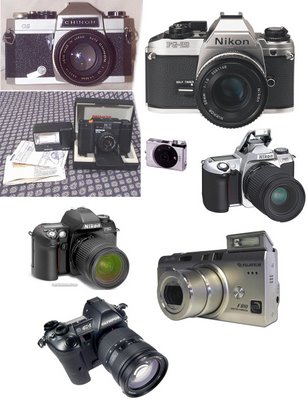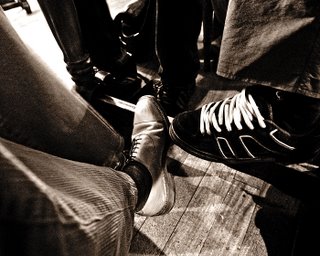[I'm away today, looking after Winnie who seems to be just a teeny bit sniffly and headachey. In lieu of me, I thought I'd hand you over to Den, my photogapher's assistant, amanuensis, and, when I go abroad, the guy who makes sure I don't get lost...]
Gosh! What an honour! Cheers, little dog! Pup and I have jointly owned a few cameras now but my history-in-cameras stretches right back to the mid-eighties when my elder brother owned a Pentax MX and I had a Chinon CS. M42 screw-mount, mechanical shutter, with a little needle on the right-hand side of the viewfinder, it was the perfect camera for a small child to learn the principles of photography on. I say perfect with two caveats: 1.) in those days, film and film processing where prohibitively expensive and 2.) this thing weighed a ton and the shutter had a kickback as mighty as a large shotgun - I was four-foot tall or so, and it's hard to get inspired about photography when you're struggling with your camera. Still, I persisted and even got a little cheap (highly subsidised, DX-coded - never understood why they bought it rather than loaded it themselves - ) Ilford FP4 film from the Photography Club in my primary school. It was there I also learnt about darkroom processing in an unventilated cupboard, filled with six other children, where we took it in turns to process our "best", i.e. least blurry, shots, and get acid all over our school uniforms.
A few years later, my father, espying a bargain in the Classifieds of the local paper which he scoured constantly and constituted his preferred reading material on any given day, bought me a Nikon FG-20. It's a fine camera - these days, I maintain that the FG/FG-20 are the most underrated of all of Nikon's manual focus SLRs, the smallest they ever made, the second lightest, with all the features of the more expensive counterparts like the FE, FM, FM2... The trouble was that, by this time, my brother and I were complete camera nerds. We'd memorised the specs of every camera on the market in 1988 (info courtesy of a huge tome written by Amateur Photographer) and, what should have been my ticket to easy-shooting, quickly grew into a bagful of budget lenses which weren't great and, eventually, weighed me down. Wanting to take pictures, rather like Andy's I suppose (though I didn't know him then), I swapped everything for a Minox 35ML.
Ah, the Minox 35ML, a piece of precision engineering surely, laden with miniature technology straight out of Cold War Germany. Designed by a guy who carved out the perfect-sized piece of wood and then decided to make a camera with the same dimensions and stick on an absolutely fabulous Minotar 28mm f2.8 which collapsed into the body when it wasn't in use. Well, it would have been a fabulous piece of engineering if it'd ever worked properly. Part of my problem was user error. The Minoxes are range-focussing cameras - you basically estimate focusing distance and hope you're right. It's not too bad with a wide-angle which gives you a lot of latitude that way - but, coming from SLRs, I never really got the hang of it... The other problem was that my particular Minox wasn't very good. The metering had a tendency to go completely do-lally, and only come back to its senses if you shook the camera... So, despite a few pleasant years service, it eventually had to go.
And go it did, traded in (once it was shaken about and then gingerly taken into a photography store) for the original Canon IXUS, with its funky APS film. The IXUS is a modern classic because it spawned countless generations of credit-card sized silver cameras. It had a pop up flash which whirred to life like something out of Edwardian science-fiction. Clearly, then, it was a Minox for the modern-day photographer. Except it wasn't. APS was awful (though, as a format, it shares much with modern digital sensor sizes); the lens was a crappy, dark affair and, very soon, they found out that the flash was liable to break off at any moment. Mine never did. It was so small that I lost it, sometime in 1999. Fortunately, my household insurance gave me my money back.
And I didn't buy another camera until the summer of 1999, when the insurance company chased me up on whether I had actually used the money they'd given me to buy another camera or not. Enter a hastily bought Nikon F65: a lovely little thing which got me all interested in SLR photography again, especially now film was cheaper, and I was going interesting places all the time. For the first time ever, I took to the streets, photographing everything, everyone, just for the sheer pleasure of it. Then came the digital revolution and everyone seemed to be trading in their cameras for whatever they could get for them, for digital SLRs. So, I upgraded to the far superior F80. For no money at all, and was rather happy with it. So was Pup, whom I'd met up with by that time.
But I couldn't resist the charms of digital forever. Nor could Pup, so we picked up a Fuji F810, just to test the water with. And then we took 8000 pictures, more than I'd ever taken with all my previous cameras combined. And this we did in a matter of months. Pup's such an inspiration that way. Digicams are great, especially the F810, with its IXUS-esque metallic body, and its shutter/aperture control - not often found on a point and shoot. You can take them everywhere: but then, Pup in particular, started getting upset with the lack of depth-of-field (because of the ultra-wide focal length of the lenses), with the barrel distortion that kept curving our New York cityscapes. So, we sold everything, and bought our Olympus E-1, from a kindly little shop in Swindon. And that was the end of that :-)












